When it comes to gardening, knowing the optimal time to plant is crucial for the success of your garden. To ensure the best possible harvest, it’s important to follow expert advice on planting timelines. You’ll want to consider the best time to plant your garden based on your geographical location and the specific vegetables or fruits you intend to grow.
Key Takeaways
- Choose a location for your garden that receives 6 to 8 hours of direct sunlight per day and has well-drained soil
- Start small and grow vegetables that you and your family will eat
- Easy vegetables for beginners to grow include lettuce, green beans, radishes, tomatoes (by transplant), zucchini, peppers (by transplant), beets, carrots, chard, spinach, kale, and peas
- Cool-season vegetables should be planted in early spring and warm-season vegetables in late spring and summer
- Raised beds can be a good option for compact garden spaces, providing better soil, yield, drainage, and weed control
- Consider block gardening to maximize space and try interplanting different vegetables
- Mulching is important for weed control, and watering should be done consistently to ensure healthy plant growth
Choosing the Right Location for Your Garden
The first step in creating a thriving garden is choosing the right location for your plants to flourish. It’s essential to choose a spot that receives at least 6 to 8 hours of direct sunlight, as most vegetables need a lot of sun to grow and produce a bountiful harvest. Therefore, it’s best to avoid areas that are shaded by trees or buildings.
Another important factor to consider when choosing a location is drainage. It’s crucial to avoid areas where water pools or flows, as excessive moisture can lead to rotted roots and other issues. Additionally, it’s advisable to select a spot that is stable and protected from strong winds and foot traffic, as these can damage plants and hinder their growth.
The quality of the soil is also important for the success of your garden. Nutrient-rich soil will help plants grow healthy and strong, so it’s best to add organic matter to thin soil to enhance its fertility. You can use compost, manure, or other natural materials to enrich the soil and create optimal growing conditions for your plants.
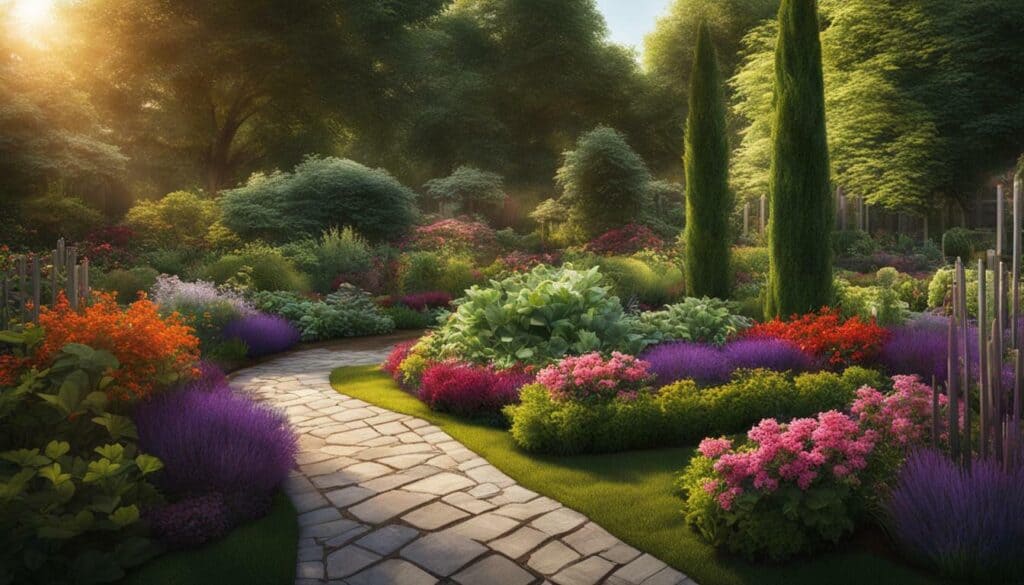
Starting small is another crucial component of successful gardening. A manageable garden size for beginners is a 10’x10′ garden in the ground or a 4’x4′ or 4’x8′ raised bed. These sizes are easier to manage, and planting a smaller garden ensures that you don’t get overwhelmed with too many plants to care for and maintain. It’s also important to plan paths for easy access to the plants for weeding and harvesting.
When choosing your vegetables, it’s best to go for easy-to-grow varieties that are productive and suitable for your area. Vegetables like lettuce, green beans, radishes, tomatoes, zucchini, peppers, beets, carrots, chard, spinach, kale, and peas are some of the easiest vegetables for beginners. Additionally, consider your family’s preferences and availability of vegetables in your area before selecting what to grow.
Finally, planting your vegetables at the appropriate time and in the right location is crucial for their success. Cool-season vegetables like lettuce and broccoli should be planted in early spring or fall, while warm-season vegetables like tomatoes and peppers should be planted in late spring or summer. It’s also advisable to plant taller vegetables on the north side of the garden to avoid shading shorter plants. Any areas of the garden that receive shade can be reserved for small, cool-season vegetables.
By following these tips, you can choose the right location for your garden, prepare the soil, select the right vegetables, and plant them at the appropriate time to ensure a flourishing garden and delicious produce.
Starting Small: Managing Your Garden Size
As a beginner, it’s wise to start small with a manageable garden size that you can easily maintain and nurture. A garden that is too large can be overwhelming and difficult to care for, especially if you have other commitments like work or family responsibilities.
Consider starting with a 10′ x 10′ garden in the ground or a 4′ x 4′ or 4′ x 8′ raised bed. These sizes are manageable and will allow you to grow enough vegetables to feed your family without feeling overwhelmed. It’s important to choose vegetables that are easy to grow and productive, such as lettuce, green beans, radishes, tomatoes, zucchini, peppers, beets, carrots, chard, spinach, kale, and peas. These vegetables are perfect for beginners because they require minimal maintenance and have a high success rate.
When choosing the size of your garden, consider the availability of vegetables at your local grocery store and your family’s preferences. Only grow what you know you and your family will eat. This will prevent wasted time and effort on growing vegetables that will go to waste.
Timing is also crucial when it comes to planting your vegetables. Warm-season vegetables should be planted in late spring or summer, while cool-season vegetables should be planted in fall. This will ensure that your vegetables grow properly and produce a high yield.
Raised beds are a great option for gardening because they offer better use of space, soil, yield, and drainage. For optimal soil health, it’s recommended to mix in organic matter with your native soil. Block gardening is another successful strategy for organizing your plants and allowing for efficient use of space and easier maintenance.
Mulching your garden is important for weed control and conserving moisture. Proper watering is also important for the health of your plants. Water your garden regularly and pay attention to the specific needs of different plants.
Starting small and managing your garden size will ensure a more enjoyable and successful gardening experience. By following these tips, you’ll be on your way to a bountiful and thriving vegetable garden.
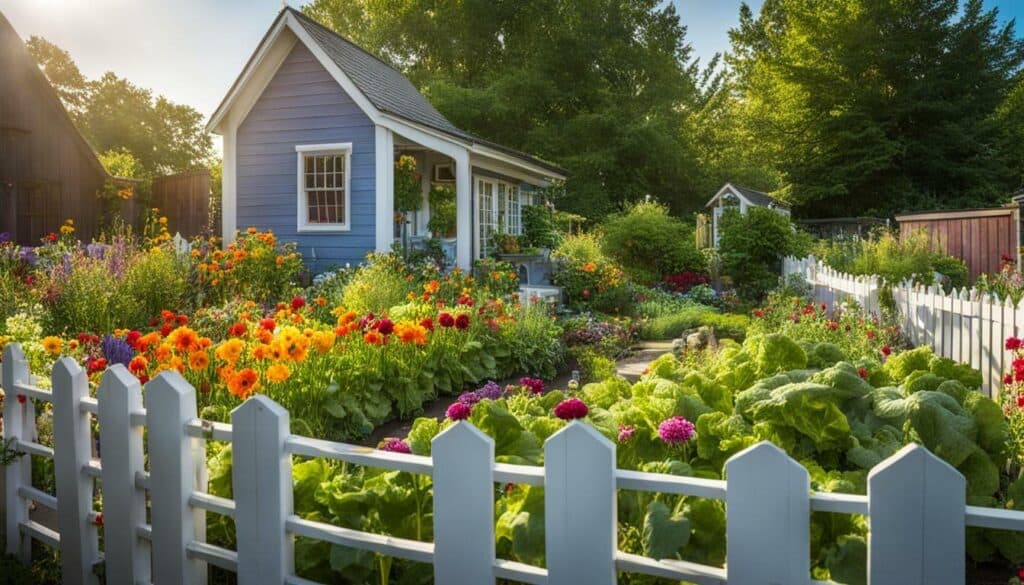
Selecting Easy Vegetables for Beginners
If you’re new to gardening, selecting easy vegetables to grow will increase your chances of success and boost your confidence. Consider personal preferences and what your family enjoys eating when choosing vegetables. It’s important to be realistic about how much you and your family can consume to avoid wasting excess produce.
It’s recommended to start with a small garden and grow vegetables that are easy to maintain and productive. Some of the easiest vegetables for beginners to grow include lettuce, green beans, radishes, tomatoes (by transplant), zucchini, peppers (by transplant), beets, carrots, chard, spinach or kale, and peas.
It’s also important to consider the availability of vegetables at local grocery stores and the suitability of certain vegetables for your specific growing conditions. When selecting a location for your garden, choose a sunny spot that receives at least 6 to 8 hours of direct sunlight per day. The soil should be well-drained, nutrient-rich, and not susceptible to becoming waterlogged. Starting with high-quality seeds and properly preparing the soil can improve the success of your garden.
Consider when and where to plant each vegetable by following planting guidelines and considering the specific needs of each plant. Raised beds can be a good option for beginners as they allow for better soil drainage and weed control. Lastly, proper care throughout the growing season, such as mulching, adequate watering, and staying on top of weeds, will help ensure a healthy and bountiful harvest.
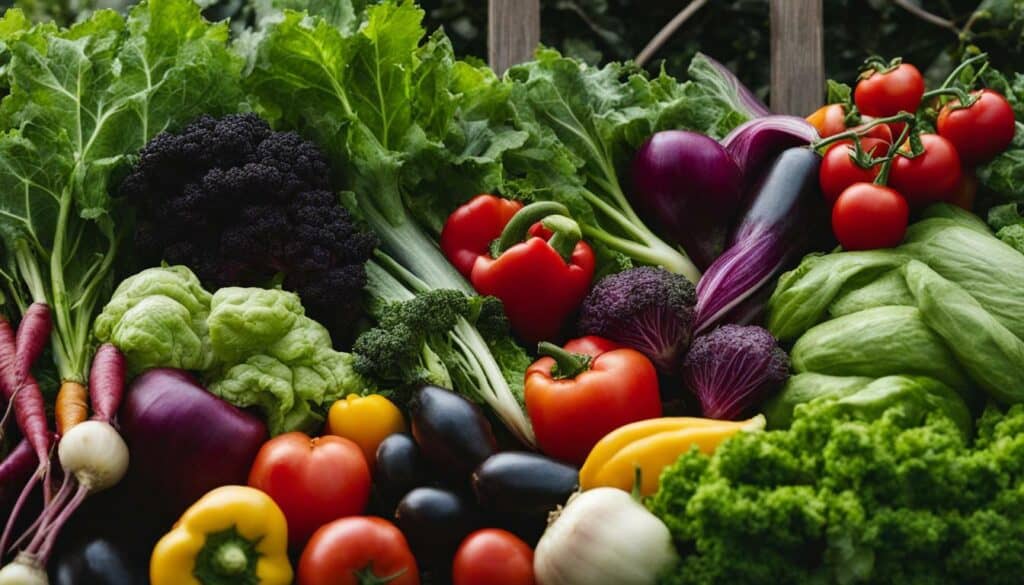
Planting at the Right Time: Cool-Season vs. Warm-Season Vegetables
Understanding the distinction between cool-season and warm-season vegetables is essential for proper timing when it comes to planting your garden. Cool-season vegetables, such as lettuce, broccoli, and peas, thrive in the cooler weather of early spring and fall. On the other hand, warm-season vegetables, like tomatoes, peppers, and cucumbers, should only be planted when the soil has warmed up in late spring and summer.
When choosing a location for your garden, it is important to consider factors such as sunlight, drainage, wind, and soil quality. Most vegetables require 6 to 8 hours of direct sunlight per day, so choose a sunny spot. Ensure that the soil drains well and doesn’t stay wet, as wet roots can lead to rotted plants. Avoid windy locations that can disrupt the growth of young plants and hinder pollination. Also, make sure the soil is nutrient-rich by adding organic matter.
To start a vegetable garden, it is recommended to begin small and grow what you and your family will actually eat. A 10′ x 10′ garden is a manageable size for beginners planting in the ground, while a 4′ x 4′ or 4′ x 8′ raised bed is a good beginner size. If you want to go bigger, a 12′ x 24′ garden is suitable for a family of four.
When choosing vegetables to grow, consider your family’s preferences and the availability of certain vegetables in your area. Be realistic about how much your family will consume and be prepared to take care of your plants throughout the growing season. It is also important to use high-quality seeds to ensure successful germination and higher yields.
Different vegetables have specific planting times, so consult a growing region/hardiness chart to determine the best time to plant in your area. For cool-season vegetables, plant them in early spring. For warm-season vegetables, wait until the soil has warmed up.
To maximize the yield of your vegetable garden, consider block gardening, which involves planting crops a certain distance apart in all directions. You can also utilize vining crops like cucumbers, tomatoes, and peas that can grow vertically up trellises or support systems.
Maintaining a healthy garden involves tasks such as mulching and watering. Mulching helps control weeds and can be done before or after planting, depending on the size of the plants. Consistent watering is important for the health and growth of the vegetables.
In conclusion, planting at the right time is essential for growing cool-season and warm-season vegetables. Understanding the needs of different vegetables, selecting the right location, and providing proper care throughout the growing season are key factors in ensuring a successful vegetable garden.
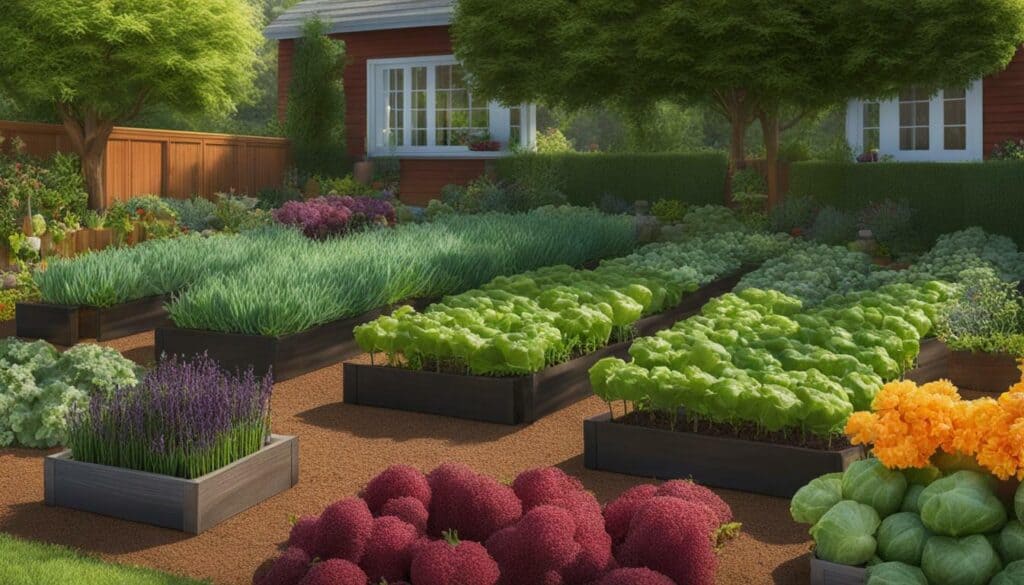
Cultivating the Soil and Creating Raised Beds
Before planting your garden, taking the time to cultivate the soil and create raised beds will provide your plants with the best possible growing conditions. When selecting a location for your garden, choose a sunny spot that drains well and is not prone to strong winds or flooding. Nutrient-rich soil is crucial for healthy plant growth, so adding organic matter to thin or nutrient-poor soil is highly recommended.
Starting small is always better than planting too much too soon. It’s essential to plant what you know your family will eat and enjoy. This will help prevent overwhelming yourself with more than you can handle. Raised beds are a great option for compact garden spaces, as they provide better soil quality, drainage, and weed control. They are also easier on your back, as you don’t have to bend down as far to tend to your plants.
| Benefits of Raised Beds: | Considerations: |
|---|---|
| 1. Better soil quality | 1. Cost of materials |
| 2. Drainage control | 2. Limited plant spacing |
| 3. Weed control | 3. Requires more watering |
When selecting vegetables to grow, choose easy varieties that are suited to your growing region. Planting times vary depending on whether you’re growing warm-season or cool-season crops. It’s important to research the specific needs of the plants you’re growing to ensure that they are receiving the care they need.

Mulching and consistent watering are essential for maintaining a healthy garden. Mulching helps control weed growth and conserves moisture, saving you time and money. Regular watering is crucial for plant health, but be sure not to overwater.
By following these tips, you can successfully cultivate the soil and create raised beds for your vegetable garden. These steps are essential for creating optimal growing conditions, which will result in a bountiful and healthy harvest.
Maximizing Space and Yield with Block Growing and Vertical Gardening
Even if you have limited space, you can still enjoy a productive garden by utilizing block growing and vertical gardening techniques. Block growing involves planting vegetables in blocks, allowing for efficient use of space and increased yield. By spacing the plants uniformly, you can maximize the number of plants in a given area. For example, radishes can be planted four inches apart, fitting 16 in a square-foot block. Tall plants should be placed to the north to prevent shading of shorter plants.
Vertical gardening is ideal for vining crops that can grow upwards, utilizing trellises or supports. This saves space and allows for efficient use of vertical space in the garden. Cucumbers, tomatoes, and beans are excellent candidates for vertical gardening. By training the plants to grow up supports, you can maximize your yield without using any additional horizontal space.
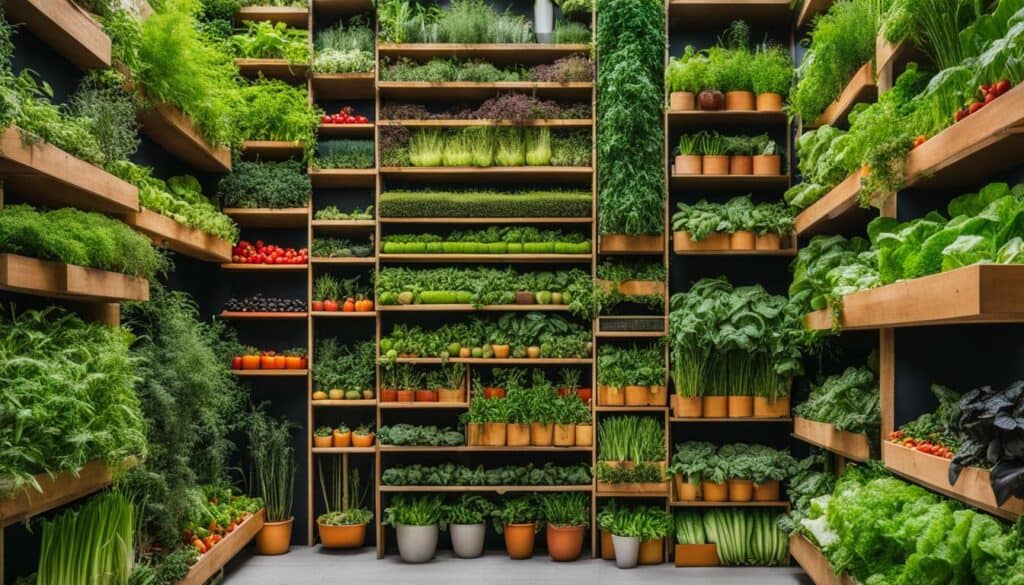
Mulching is essential for weed control in the garden. Mulch should be applied before planting, and the amount needed can be calculated using the length and width of the beds. Watering should be done consistently, ensuring that plants receive adequate moisture without overwatering. By implementing these techniques, gardeners can maximize their space and yield, enjoying a bountiful harvest of fresh vegetables from their own backyard.
Mulching Your Garden for Weed Control and Moisture Conservation
Mulching your garden is a simple yet effective way to control weeds and conserve moisture, ensuring optimal conditions for your plants to thrive. Not only does mulching prevent weed growth, but it also retains moisture in the soil, reducing the need for frequent watering.
When selecting the type of mulch to use, consider the size and location of your garden. Organic mulches such as bark, straw, or compost are best suited for larger gardens, while smaller gardens benefit from synthetic materials like black plastic or landscape fabric.
The amount of mulch needed can be calculated based on the square footage of your garden. Aim for a depth of 2 to 3 inches for organic mulches and 1 inch for synthetic materials. It’s important not to over-mulch, as this can prevent water from reaching the soil and suffocate your plants.
To properly mulch your garden, spread the material evenly over the soil, making sure to leave a small space around the base of each plant. This will prevent the mulch from touching the plant and causing rot.
Mulching can also provide an attractive appearance to your garden, while controlling weeds and conserving moisture. So don’t hesitate to adopt this simple yet effective method to improve your gardening success.

Regular Watering and Plant-Specific Care
Providing regular water and catering to the specific needs of your plants are vital elements to ensure a healthy and flourishing garden. Water is essential for plant growth and helps transport nutrients throughout the plant. The amount of water required varies depending on the plant type, climate, and soil type. In general, most vegetables require about an inch of water per week, either from rainfall or irrigation.
It is important to water your garden consistently, but also avoid overwatering, which can lead to root rot and disease. A good rule of thumb is to water deeply and less frequently, rather than a little bit every day. Water your garden in the morning or evening when temperatures are cooler to reduce water loss from evaporation.
In addition to regular watering, it is crucial to pay attention to the specific needs of your plants. Some plants, such as tomatoes and peppers, require staking or trellising for support, while others, like cucumbers and beans, can benefit from vertical gardening techniques. Certain plants, like lettuce and spinach, prefer cooler temperatures and may need shade in the heat of summer.
Regular monitoring for pests, diseases, and nutrient deficiencies is also important for plant-specific care. Signs of common garden pests, such as holes in leaves or wilting, should be addressed promptly to prevent further damage. Similarly, nutrient deficiencies can cause stunted growth or yellowing leaves and may require fertilization or soil amendment.
To ensure optimal growing conditions, it is a good idea to invest in proper garden tools and equipment, such as watering cans, hoses, and sprayers. By taking these steps, you can enjoy a productive and healthy vegetable garden.
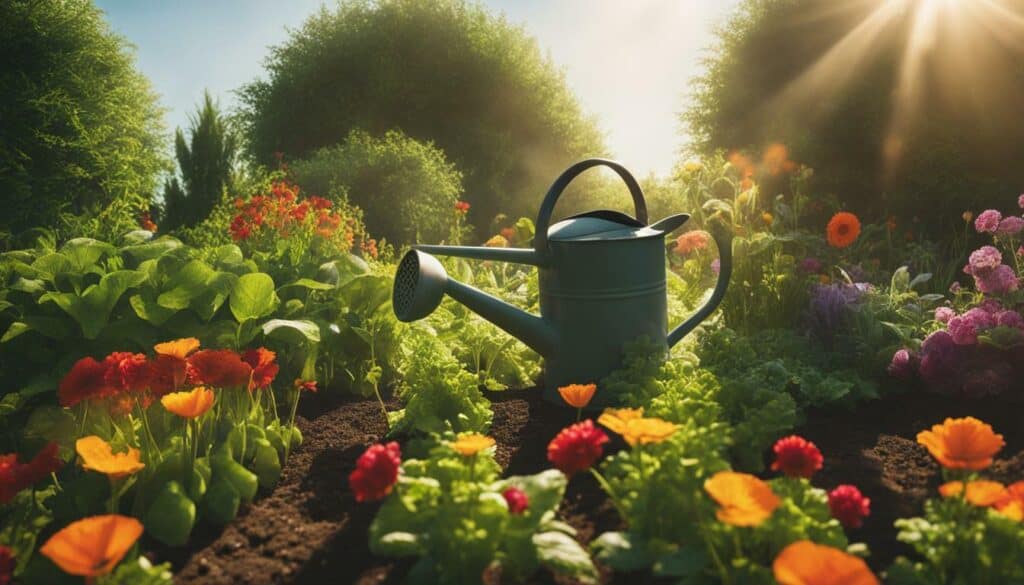
“Watering the garden consistently and mulching to control weeds are important maintenance tasks. Additionally, regular monitoring for pests, diseases, and nutrient deficiencies, as well as providing adequate support for plants, are vital for plant-specific care.”
Conclusion
Starting a vegetable garden can be a rewarding and fulfilling hobby, providing you with fresh and delicious produce right from your backyard. It may seem daunting at first, but with the right guidelines and knowledge, anyone can successfully grow their own vegetables.
By following these essential gardening tips for successful planting, you’ll be well-equipped to create a thriving garden that yields an abundance of fresh and delicious produce.
When starting a vegetable garden, it is important to choose a sunny location with well-drained soil. The size of your garden should be manageable, and it’s better to start small and grow what you know you and your family will eat. It’s also important to choose easy vegetables that are suited for your growing region and to plan your gardening timeline based on whether you’re growing warm-season or cool-season plants.
Improving the soil is crucial for the success of your vegetable garden. Adding organic matter to the soil can greatly enhance its fertility and health. Raised beds can be a great option for a compact garden space, offering better soil drainage, weed control, and space optimization. When choosing vegetables, it’s important to consider your family’s preferences, the availability of vegetables at your grocery store, and your ability to care for the plants throughout the growing season.
Proper planning and timing are essential when it comes to planting your vegetables. Some vegetables are best planted in early spring, while others are more suited for planting after the last frost. It may be easier for beginners to start with starter plants instead of seeds. Arranging your vegetables in blocks can help maximize space and yield. Mulching is important to control weeds, and consistent watering is essential for the health and growth of your plants.
In conclusion, starting a vegetable garden requires patience, knowledge, and a bit of creativity. By following these guidelines and tips, you can enjoy the benefits of growing your own fresh produce and experiencing the joy that gardening brings. So roll up your sleeves, choose your favorite vegetables, and start your own vegetable garden today!
FAQ
Q: What factors should I consider when choosing the location for my garden?
A: You should look for a location that receives 6 to 8 hours of direct sunlight per day, has good drainage, stability, and nutrient-rich soil.
Q: How big should my garden be when I’m just starting out?
A: It’s best to start small with a manageable garden size, such as a 10′ x 10′ plot in the ground or a 4′ x 4′ or 4′ x 8′ raised bed.
Q: What are some easy vegetables to grow as a beginner?
A: Some easy vegetables for beginners include lettuce, green beans, radishes, tomatoes (by transplant), zucchini, peppers (by transplant), beets, carrots, chard, spinach, kale, peas, and herbs.
Q: When should I plant cool-season and warm-season vegetables?
A: Cool-season vegetables should be planted in early spring or fall, while warm-season vegetables are planted after the last frost.
Q: How can I maximize space and yield in my garden?
A: You can maximize space and yield by using techniques like block growing and vertical gardening.
Q: Why is mulching important for my garden?
A: Mulching helps control weeds and conserves moisture in your garden.
Q: How often should I water my garden?
A: It’s important to water your garden regularly and pay attention to the specific needs of different plants.
What Are the Best Seasons to Plant in Your Dream Garden?
When planning your dream garden, it’s crucial to choose the best seasons for planting. Follow these dream garden tips and tricks to ensure success. In general, spring and fall are ideal as they offer mild temperatures and ample moisture. However, specific plant types may have unique requirements, so research is key. Consider your climate, the plant’s growth cycle, and the availability of sunlight to determine the perfect planting time for your dream garden.
Source Links
- https://www.goodhousekeeping.com/home/gardening/a32675326/gardening-101/
- https://www.skh.com/thedirt/vegetable-gardening/
- https://www.almanac.com/vegetable-gardening-for-beginners
- https://gardengoodsdirect.com/blogs/news/ultimate-guide-to-seasonal-gardening
- https://sebsnjaesnews.rutgers.edu/2020/04/choosing-the-right-location-for-your-vegetable-garden/
- https://www.gardensthatmatter.com/choose-garden-location/
- https://www.almanac.com/where-put-vegetable-garden
- https://www.bhg.com/gardening/yard/garden-care/ten-steps-to-beginning-a-garden/
- https://www.gardensalive.com/product/first-time-veggie-gardenwhere-to-start
- https://youshouldgrow.com/vegetable-gardening-tips-for-beginners/
- https://www.bhg.com/gardening/vegetable/vegetables/planning-your-first-vegetable-garden/
- https://growagoodlife.com/gardening-tips-beginners/
- https://www.nourishingpursuits.com/garden/grow-cool-season-versus-warm-season-plants/
- https://ourstoneyacres.com/the-difference-between-cool-and-warm-season-veggies
- https://extension.psu.edu/cool-season-vs-warm-season-vegetables
- https://www.creativevegetablegardener.com/prepping-spring-garden-beds/
- https://www.gardeners.com/how-to/raised-bed-basics/8565.html
- https://savvygardening.com/planting-a-raised-bed/
- https://www.almanac.com/how-grow-vertically-your-garden
- https://www.gardeningknowhow.com/edible/vegetables/vgen/increase-garden-yield.htm
- https://www.rainchainsdirect.com/pages/10-tips-to-increase-the-yield-of-your-garden
- https://www.bobvila.com/articles/mulching-the-garden/
- https://extension.sdstate.edu/organic-garden-mulches-conserve-moisture-and-prevent-weeds
- https://extension.unh.edu/resource/garden-mulches-fact-sheet
- https://www.almanac.com/when-water-your-vegetable-garden-watering-chart
- https://www.gardeners.com/how-to/when-to-water/8108.html
- https://extension.okstate.edu/fact-sheets/basic-plant-care-understanding-your-plants-needs.html
- https://content.ces.ncsu.edu/home-vegetable-gardening-a-quick-reference-guide
- https://www.ocregister.com/2023/09/08/fall-is-the-best-time-to-plant-5-tips-to-get-your-garden-ready/

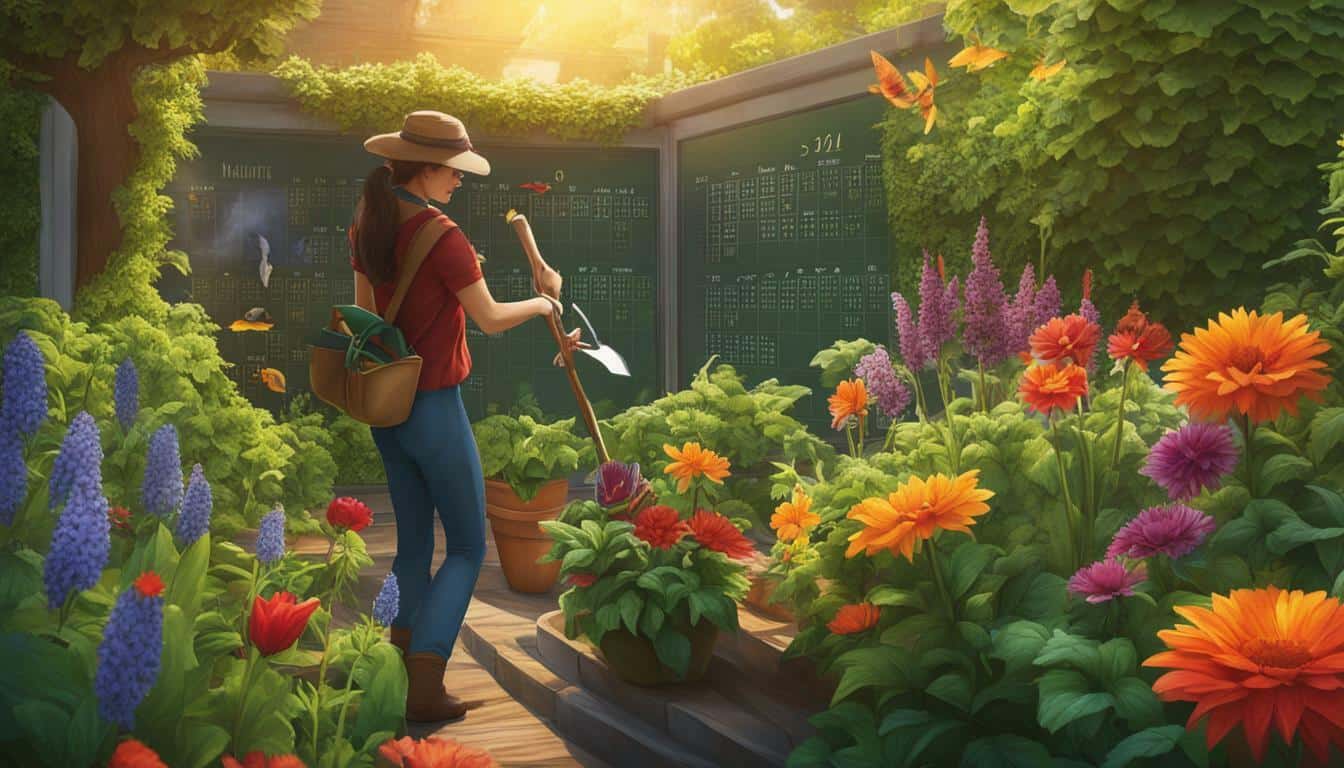



Leave a Reply